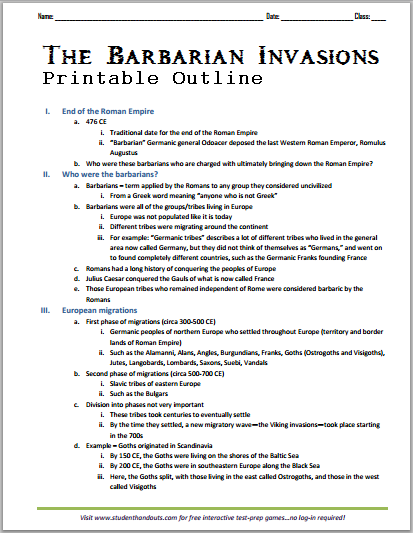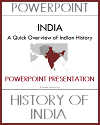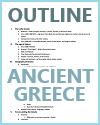| Barbarian Migrations Outline |
| www.studenthandouts.com > World History > Barbarian Migrations > Barbarians Outlines & PPTs |
This free printable outline on the Barbarian Migrations is four pages in length. In the middle and at the end, there are review questions which teachers can pose to students to verify comprehension and recall. I. End of the Roman Empire
I. End of the Roman Empirea. 476 C.E. i. Traditional date for the end of the Roman Empire ii. "Barbarian" Germanic general Odoacer deposed the last Western Roman Emperor, Romulus Augustus b. Who were these barbarians who are charged with ultimately bringing down the Roman Empire? II. Who were the barbarians? a. Barbarians—term applied by the Romans to any group they considered uncivilized i. From a Greek word meaning "anyone who is not Greek" b. Barbarians were all of the groups/tribes living in Europe i. Europe was not populated like it is today ii. Different tribes were migrating around the continent iii. For example: "Germanic tribes" describes a lot of different tribes who lived in the general area now called Germany, but they did not think of themselves as "Germans," and went on to found completely different countries, such as the Germanic Franks founding France c. Romans had a long history of conquering the peoples of Europe d. Julius Caesar conquered the Gauls of what is now called France e. Those European tribes who remained independent of Rome were considered barbaric by the Romans III. European migrations a. First phase of migrations (circa 300-500 C.E.) i. Germanic peoples of northern Europe who settled throughout Europe (territory and border lands of Roman Empire) ii. Such as the Alamanni, Alans, Angles, Burgundians, Franks, Goths (Ostrogoths and Visigoths), Jutes, Langobards, Lombards, Saxons, Suebi, Vandals b. Second phase of migrations (circa 500-700 C.E.) i. Slavic tribes of eastern Europe ii. Such as the Bulgars c. Division into phases not very important i. These tribes took centuries to eventually settle ii. By the time they settled, a new migratory wave—the Viking invasions—took place starting in the 700s d. Example – Goths originated in Scandinavia i. By 150 C.E., the Goths were living on the shores of the Baltic Sea ii. By 200 C.E., the Goths were in southeastern Europe along the Black Sea iii. Here, the Goths split, with those living in the east called Ostrogoths, and those in the west called Visigoths IV. Germanic culture a. Economy i. Hunters and farmers b. War culture i. Tribes always fighting one another c. Religion i. Valhalla – warriors’ heaven ii. Animal and human sacrifice iii. Germanic pagan gods survive in our days of the week 1. Tiu = Tuesday 2. Woden = Wednesday 3. Thor = Thursday 4. Frig = Friday 5. FYI: Saturday is named after the Roman god Saturn, Sunday is named after the sun, and Monday is named after the moon iv. Gradually converted to Christianity through exposure to the Roman Empire and Christian missionaries V. Germanic justice a. Trial by ordeal i. Innocence proven by survival of a trial ii. For example, retrieving an object from boiling water or walking over hot coals iii. If the person survived the ordeal, or healed quickly, the verdict was innocent iv. Modern version—Salem Witchcraft Trials b. Trial by combat i. Winner of the fight is innocent of the crime, or winner of the dispute ii. Modern era version—dueling c. These trials survived through the Middle Ages in Europe VI. Angles, Saxons, and Jutes a. 400s C.E. b. Moved into Britannia as the Roman Empire declined c. Gave the area its name i. England = "Angle's land" d. Old English language i. Most closely related to Frisian, a German dialect e. Beowulf VII. The Burgundians a. Late 400s to 530s b. Founded a kingdom in southern Gaul (modern France) in the Valley of the Rhone VIII. The Vandals a. Led by Genseric (lived circa 389 C.E.-477 C.E.) i. Crossed Gaul, to Spain, to north Africa ii. Established Vandal kingdom around Carthage and on islands such as Corsica and Sardinia b. Famously sacked Rome in 455 C.E. i. After murder of Emperor Valentinian III ii. Plundered city’s riches—origin of term vandalism iii. Kidnapped emperor’s widow, Licinia Eudoxia, and daughters, Eudocia and Placidia 1. Eudocia was married off to Huneric, the son of Genseric c. Finally conquered by the Eastern Roman Empire in 533 C.E. IX. The Franks a. Kingdom in Gaul i. Became known as "France" after the Franks b. United under King Clovis (lived circa 466-511 C.E.) i. First king of France (ruled 481-511 C.E.) ii. Married Christian Burgundian princess, Clotilde iii. Converted to Christianity X. Review questions a. What is the traditional date for the end of the Roman Empire? b. Who were the barbarians? c. Describe elements of ancient Germanic culture that are still with us. d. How did England get its name? e. Explain the origin of the term vandalism. f. How did France get its name? XI. The Lombards a. Invaded Italy following the death of Emperor Justinian (Eastern Roman Empire) in 565 C.E. b. 568 C.E. i. Under leadership of Alboin ii. Set up a powerful kingdom in the Italian peninsula 1. Modern Italian region of Lombardy 2. Conquered by France’s King Charlemagne in 774 C.E. XII. The Huns a. From Asia, east of the Volga River i. Their migration pushed the Goths into the Roman Empire, circa 370 C.E. b. Led by Attila the Hun (lived 406-453 C.E.) c. Campaign in Gaul i. Sacked various cities ii. Finally defeated by alliance of Romans and Visigoths under General Aetius at the Battle of Chalons (451 C.E.) d. 450 C.E.—Emperor Valentinian III's sister, Honoria, sent him an engagement ring (to avoid a forced marriage) i. Attila used this pretext to attempt an invasion of Rome (452 C.E.) ii. According to legend, Pope Leo I, helped by St. Peter and St. Paul, convinced Attila at the Po River to halt his advance iii. Attila retreated and died a year later, allegedly by choking to death on his own blood (from a nosebleed) while in a drunken stupor following his wedding to Ildico XIII. The Goths a. Split into Visigoths (West Goths) and Ostrogoths (East Goths) around the year 200 C.E. b. The Visigoths (West Goths) i. Led by Alaric I (lived circa 370-410 C.E.) ii. Pushed into the Roman Empire by the westward migration of the Huns 1. 378 CE—Romans defeated by the Visigoths at the Battle of Adrianople iii. Sacked Rome in 410 C.E. iv. Eventually settled in Spain 1. Visigothic kingdom in Spain lasted until Arab Muslim invaders arrived in 711 C.E. a. These Muslim rulers were not expelled until completion of the Reconquista under Ferdinand and Isabella in 1492 c. The Ostrogoths (East Goths) i. Led by Theodoric the Great (lived 454-526 C.E.) 1. Raised at the court in Constantinople as a traditional hostage, returning to the Ostrogoths at age 31 ii. Kingdom in Italy 1. Capital city—Ravenna a. Center of art and learning 2. Conquered by Emperor Justinian (Eastern Roman Empire) in 554 C.E. XIV. Odoacer and the fall of Rome a. 476 C.E.—the barbarian general, Odoacer, dethroned the last Western Roman emperor, Romulus Augustus i. No one even knows for certain which tribe he belonged to, only that he was Germanic ii. The conquest of the Western Roman Empire was a long process, and a lot of factors contributed to Rome’s decline b. This date (476 C.E.) is traditionally used for the end of the Roman Empire and the beginning of the Middle Ages, circa 500-1400 (or Dark Ages, circa 500-800) XV. The Dark Ages (500-800 C.E.) a. Universal rule under Rome collapsed i. Separate barbarian kingdoms ruled in Rome’s place b. Economic decline i. Trade 1. Infrastructure fell apart (roads and bridges) 2. Piracy in the seas hurt trade 3. Few coins minted ii. Industry 1. With limited trade, little demand for goods 2. Fewer skilled workers trained 3. Depopulation of cities (workers returned to farms) c. Culture and learning i. Illiteracy grew ii. Ancient wisdom of Greece and Rome largely lost 1. Preserved by Christian monks (Europe) and Muslim Arabs (Middle East and northern Africa) XVI. Review questions a. Describe the conquests of Attila the Hun. b. At what battle, fought in 378 C.E., did the Visigoths defeat the Romans? c. Where did the Visigoths eventually settle and establish a kingdom? d. Who made Ravenna an important cultural center? e. How was Europe governed following the fall of Rome? f. Explain why the period of 500-800 C.E. is commonly referred to as the Dark Ages. Click here to print. Click here for a PowerPoint version of this outline. |
 |
 |
 |
 |
 |
 |
|---|
| www.studenthandouts.com > World History > Barbarian Migrations > Barbarians Outlines & PPTs |






